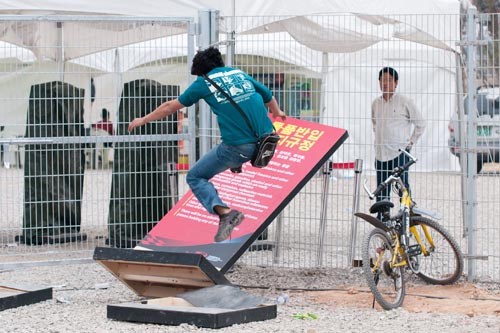Korea’s 1st F1 hits lots of speed bumps

Park Min-young, a 28-year-old from Busan, destroys a sign in frustration over the bad organization of the 2010 Formula 1 Korean Grand Prix on Saturday at the Korea International Circuit in Yeongam, South Jeolla. By Jung Seung-hyun
After the conclusion of the Formula One race in Yeongam, South Jeolla, local officials were patting themselves on the back - while also admitting to some embarrassing screw-ups.
“I would like to thank the people of South Jeolla, the government, event personnel and volunteers for all the support,” said Governor Park Joon-yung.
“We have successfully held the F1 event by building one of the finest circuits in the world in South Jeolla, which is one of the most underdeveloped areas in Korea,” he said. “Although everything didn’t go as planned, I want you to think of this as a long term investment for the future.
“No country can hold such an event perfectly from the start, so we will go step by step and improve things in the coming years,” Park added.

Entrepreneur Park Min-young, 28, traveled all the way from Busan to see the race, and he had a representative experience.
“I waited for the shuttle at the station starting at 1 p.m.,” he said. “But the shuttle, which was supposed to come every 5 to 10 minutes, did not come until 2:30. When I came to the circuit at 2:50 and tried to get in, I was denied access and not one person knew where I should ask to get answers.
“I bought two tickets over 300,000 won each and people next to me with a baby bought four Silver tickets over 1 million won each,” Park said.
“Nobody from KAVO [event organizer Korea Auto Valley Operation] came to the entrance or explained anything to us, and I couldn’t believe the fact that there was nowhere to get information or vent my frustrations.”
Park said he wanted an apology from the organizers, but hasn’t been given one.
Another problem with tickets was that the local government gave thousands of free passes to university students to make sure the stands were filled. The local government also required its officials to sell tickets to their family and friends.
“Since the event is fairly unknown in Korea, I did ask for some cooperation in terms of tickets, and I am truly sorry for all the inconveniences that have been caused,” said Governor Park. “Also, there were some confusion and dissonance as the organizing committee was run simultaneously with us and KAVO. We will look into all wrong procedures and improve on these matters.”
The facilities left a lot to be desired. The spectators stands were rickety, like those at a high school sports field, and KAVO was forced to close certain sections while continuing construction on stands during the three days of practices and races.
Most of the parking areas and pedestrian walks were unpaved, creating huge amounts of dust for the first two days and large mud puddles on the day that it rained during the Grand Prix. After sunset, most circuit areas had no lighting, leaving pedestrians in the pitch black.
Volunteers who were supposed to help visitors rarely knew the answers to questions. Very few spoke any language other than Korean, and few knew where certain places at the event were.
KAVO said that organizing will improve in the coming years.
“This circuit was a great accomplishment for us, as what would usually take about five years in Europe took us just over three years to accomplish,” said Kim Jae-ho, the general manager of KAVO’s marketing department.
“We know that there were many problems with the accommodations and site surroundings, but a large hotel is already planned to be built nearby, and companies have shown interest.”
Kim added, “The accommodations will not be the same at next year’s event.”
“During that time, we will do our best to make motorsports in Korea an event that the whole family can enjoy, like that of Nascar in the United States,” Kim said.
Governor Park said that in the next two weeks, F1 related facilities will be disassembled and taken away in advance of scheduled motorsporting events starting early November. South Jeolla said that between Nov. 26 and 28, the F3 event, the gateway to entering F1, will be held.
By Jung Seung-hyun [seungjung@joongang.co.kr]










with the Korea JoongAng Daily
To write comments, please log in to one of the accounts.
Standards Board Policy (0/250자)